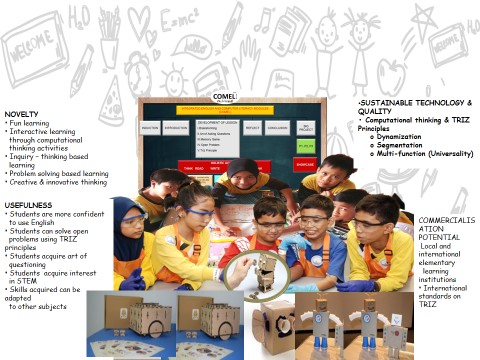COMEL: Integrating Computational Thinking (CT) Across STEM
– Headed by Prof. Dato’ Dr. Halimah Badioze Zaman.
COMEL: Computational Thinking, Optimization, Meta Cognition, Engagement Strategy, Learning Outcomes
Many children in the rural states of Malaysia are struggling with learning the English Language and STEM. These children have problems in thinking creatively and logically. These problems are commonly ignored during the early stages of their schooling and are detected only when it is already too late. The purpose of this research is help them acquire critical thinking, scientific thinking and problem solving skills through computational thinking Learning Model.
INTRODUCTION OF RESEARCH
COMEL is an acronym for a research programme integrating Computational Thinking (CT) with the teaching of English across Science, Technology, Engineering and Mathematics (STEM). This study is currently conducted at four (4) elementary schools in the rural state of Malaysia, Kedah amongst 4th and 5th grade school children. This is a special programme under the patronage of Her Royal Highness, the Sultanah of Kedah. This research based programme is conducted by researchers from Universiti Kebangsaan Malaysia (UKM) comprising of researchers from the Institute of Visual Informatics (IVI), Faculty of Education and CITRA centre, and the Kedah State Government via its Department of Education. The main objective of the COMEL programme is to help children acquire computational thinking through a technique called TRIZ by integrating learning of English as a second language across a thematic approach using STEM; to help students acquire confidence to practice and use spoken and written English, and at the same time acquire creative and innovative skills through computational thinking; to use ICT in education to enhance learning of English and at the same time, motivate them to have interest in STEM; and to help students acquire sharing and team work in solving problems in a fun and engaging way through ‘hands-on’gamification approach.
FINDINGS OF RESEARCH
Therefore, findings of this study generally showed that the COMEL learning model and modules were effective in integrating computational thinking through the subject of English across STEM domain. The study was conducted based on two observational assessment: Observational Assessment 1 (OA1) and Observational Assessment 2 (OA2). The first observational assessment (OA1a & OA1b) was conducted with the objective to assess the effectiveness of the COMEL learning model as a whole, based on its five (5) components and five (5) attributes (based on the COMEL acronym). Generally, the findings showed that majority of the respondents were of the opinion that the components and attributes were effective in integrating computational thinking in English across STEM. The second observational assessment (OA2) was conducted to investigate the effectiveness of the COMEL model based on the seven (7) concepts of computational thinking (CT). Findings of the study showed that all the concepts were generally well embedded both in the content of the activities and tasks created as well as the understanding of the concepts by the students, manifested by their actions and behaviour during the activities and tasks undertaking sessions. The study also conducted a simple analysis to triangulate results to see how the students felt about the COMEL project. Generally, majority of the students (93%) enjoyed the COMEL class and said they would be sad when the project ends. Majority of the students (83%) also contributed the success of the project to the COMEL teachers, the engaging and fun hands-on activities, the various media used and the leaderboard. Based on previous past research on CT across STEM, studies conducted at tertiary level showed early positive success and this study conducted in an elementary level is the first study integrating CT with English across STEM domain in Malaysia and perhaps globally. This early study by the researchers from UKM, show great potential for it to be used locally and globally, to help students acquire the 21st century skills of Computational Thinking (CT) to help them find solutions for problems not just in the computer science and other sciences domains, but to solve everyday life problems of the future.
FUTURE WORKS
Very little work has been done on the use of computational thinking (CT) to help learners acquire this new skills that encompass seven (concepts) of CT. Thus incorporating it into the COMEL learning modules together with the components and attributes of the COMEL learning model is novel. The model has to be further enhanced and specific materials for learning both conventional and electronic need to be designed and developed. Thus, future work need to be conducted to design and develop instrumentations-based materials (i-COMEL), to help learners acquire new computational thinking skills through new fusion-technology devices that can collect and share data for learning any subject domain (sciences and social sciences), integrated with Computational Thinking (CT ) tools.
